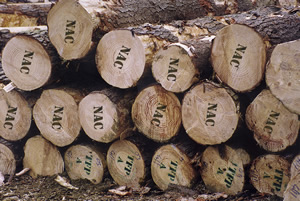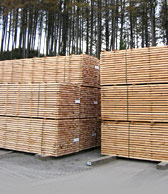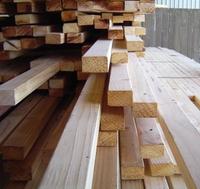
Reliable, Renewable, Revolutionary... New Zealand Radiata has a reputation as the world's most versatile wood.
As one of the world’s leading suppliers of high-quality Radiata, New Zealand has developed world-leading clearwood production technology.
New Zealand’s foremost foresters and scientists have, for decades, worked collaboratively on research and development, forest management, harvesting and processing to develop timber with an even texture and moderate density, harvested with as little impact on the environment as possible.
All 1.8 million hectares of the New Zealand’s plantations are renewable and nearly half are FSC certified.
New Zealand’s focus on the sustainable supply of premium quality wood for international markets combined with the ability to produce export quality logs in just 25 years, creates a unique edge on the global scene.
NAC Trading is actively involved in competitive stumpage purchase and management. Not only does this secure supply for our customers, it enables us to monitor and control log grade mix and associated quality. We also are developing strong domestic relationships with local processing plants and are producing a wide range of high quality sawn lumber products which are exported to our Chinese customers.
Read an article about NAC Trading log exports in the Southland Times.
Key Features
 New Zealand Radiata boasts some key features that place it head and shoulders above it’s competitors – no matter what your use.
New Zealand Radiata boasts some key features that place it head and shoulders above it’s competitors – no matter what your use.
- Natural
New Zealand Radiata benefits from selective sawing and processing as well as low manufacturing energy inputs. The result is a natural wood product developed from renewable resources.
- Sustainable
The continuing establishment of new forests, combined with New Zealand Radiata’s rapid maturation rates ensures long-term security of supply.
- Well Managed
A continuing programme of genetic improvement and advanced forest management focuses on superior yield and enhancing desirable characteristics.
- Strong
The strength of Radiata compares favourably with most traditional construction lumber. Appropriate conversion processes ensure that the higher-strength wood fibre near the outside of the log is sawn for structural applications.
- Versatile
Excellent for an impressive range of structural and appearance applications, New Zealand Radiata is easily kiln dried or chemically treated to produce stable and long-lasting products.
Guaranteeing Quality
 More than half of New Zealand’s Radiata forests are pruned three times in the first 10 years of life. This unique but labour intensive approach produces the highly prized, knot-free, Clearwood.
More than half of New Zealand’s Radiata forests are pruned three times in the first 10 years of life. This unique but labour intensive approach produces the highly prized, knot-free, Clearwood.
Pruning regimes vary but, in general, the first prune or “lift” is done when trees are 5~6m high. There are two more prunings before the trees reach 8m – always leaving 3~4m of photosynthesising crown.
Trees grow upwards and outwards. If a nail is hammered in 5m up the tree, it will remain at that height from the ground. But it will be progressively covered by new wood as the tree lays down more rungs with each season.
The same applies to pruned branch stubs – they stay at the same height and clearwood covers them as the tree grows. The bark will retain the pattern of “whirls” from where the branches were pruned, but don’t be deceived: there is excellent clearwood directly below.
The defect “core” in the centre of the pruned is narrow and well covered with high-value clearwood.
Graded to Meet Your Requirements
 New Zealand Radiata comes in a wide range of stringently adhered to grades, allowing buyers to specify their preferred quality and to match timber with their end use.
New Zealand Radiata comes in a wide range of stringently adhered to grades, allowing buyers to specify their preferred quality and to match timber with their end use.
Grading is determined by size (diameter and length), shape (straightness and taper), branching and wood property features. All grades typically feature timber that is healthy with no insect attack, decay, ternal splits or growth stresses. Because many trees are pruned to produce ‘clearwood’ often the knotty core is restricted to a small cylinder surrounding the pith.
New Zealand Radiata Log Types and Recommended Uses
Pruned Peeler
• High-quality, large, straight logs
• For sliced or peeled veneer, ply and decorative overlay veneers
Industrial Peeler
• Large, straight unpruned logs
• Knotty plywood grades and LVL.
Pruned Sawlog
• Large, straight logs
• Clear and appearance-grade lumber, and industrial grades.
Small Branch Sawlog
• For high-strength lumber.
Large Branch Sawlog
• Temporary construction lumber, packaging and appearance components.
Long Internode Sawlogs
• Wide branch clusters
• Ideal for recovery of clearwood furniture and joinery.
Posts and Poles
• Small-medium, straight logs
• Low spiral grain, for engineering and ground contact; must be chemically treated.
Fibre and Pulp Logs
• Wood but not matching any of the above classes.
• Used for pulp, reconstituted and panel products.
Technological advances have seen log scaling take a massive leap forward with the introduction of a new device that uses acoustic science to measure log quality.
The device works by pressing a sensor against the end of the log and hitting the log with a hammer. By calculating the acoustic speed of the hit along the log, the device is able to provide an immediate and accurate measurement of the stiffness of the wood.
This information improves yields of high value wood products and gives up to a 10% increase in profit by allowing operators to measure and segregate logs by quality and value before they leave the forest site.
Currently, nearly 50% of New Zealand’s commercial forests are third party certified (mostly to FSC criteria) and around 50 New Zealand companies hold “chain of custody” certificates confirming they have systems in place to track certified timber through their production lines.
A National Standard for Plantation Management in New Zealand was released for pubic comment in November 2002. Extensively debated by forestry and environmental stakeholders, it creates a certification framework for New Zealand forestry that will set an international benchmark for sustainable management of forests.
